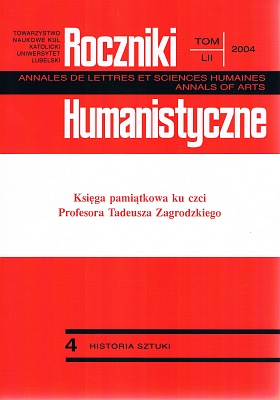Gentile da Fabriano’s painting of Mary with Infant Jesus as an example of the type of Madonna dell’Umiltà
Abstract
Gentile da Fabiano's painting of Mary with Infant Jesus as an example of Madonna dell'Umiltà is set deeply in the style of the art of this painter who lived at the close of the Middle Ages; and especially of the international Gothic and early Renaissance. Monographers of the painter, e.g. A. De Marchi, point to his characteristic Lombardic style that was situated between the north painting and the Renaissance Italian painting. The painting of Mary with Infant Jesus that is analyzed here, and that is kept in the Perugia museum, was already mentioned in G. Vasari's Lives. It was painted for San Domenico Church in Perugia, and it is defined as “beautiful”. G. B. Cavalcaselle who studied Italian art, saw it in that town in 1861 in the novitiate chapel of the San Domenico monastery. In 1863 it was given to Galleria Nazionale dell'Umbria, where it is kept until today.
The work of the painter who came from Fabriano, a place situated in the mountains in the Marche region, as it is confirmed by Italian scholars, e.g. R. Longhi, was initially connected with Orvieto, a town that was under a strong influence of the Siena art. It was a center in Italy where fabulous decorations, enamels, stained glass and mosaics were made. It was the artistic circle of that town that determined the quality of the early works of the painter. De Marchi thinks that Gentile could have remained there until 1395 and then went to the Sforza court in Milan and Pavia, where there was some interest in natural sciences and reflecting nature in art. The third important place was Venice, where the painter also enjoyed immense fame. A few surviving paintings come from the Venetian period, among them Madonna with the Infant, presently at Pinacoteca Nazionale in Ferrara, the altar from Valle Romita, a polyptych with the scene of Coronation of Virgin Mary in its central part. However, the most prestigious order came from Pal Strozzi in Florence. It was a painting of The Magi's Adoration for Santa Trinità Church and one of Mary with Infant Jesus and the Saints.
The type of paintings of Mary the Meek was already widely spread in the circle of Italian art. Its source was the Gospel, especially according to St Luke (Luke 1, 38, 42), and the commentaries on the Virgin Mary written by the Fathers of the Church. This current of Marian piety was developed and consolidated by St. Bernard who, referring to tradition, and especially to St Augustine's writings, made the teaching about the importance of humilitas in human life, about Christ's humility, more profound. Imitation Mariae is a guarantee for the faithful of making them closer to God through the Virgin Mary. A mystic trend of piety developed in the Franciscan and Dominican orders and it contributed to consolidation of the sense of humiliation in man's life and, by the very fact, of piety at the close of the Middle Ages. The texts and the style of prayer propagated in the circle of St. Clara of Assisi, St. Anthony of Padua, St. Bernardino of Siena, St. Catherine of Siena, gave a broad basis for paintings of Mary the Meek, sitting on the grass or on a small stool.
The paintings, popular in the Italian circles, and also in the north ones, became a new type of picture that was taken from the dogmatic cycles illustrating the meaning of Salvation. The scholar M. Meiss suggests that the connotation of the word humilitas with the earth or the ground, suggested by Isidore of Seville and later developed by St. Bonaventure and Catherine of Sienna, had a significant influence on formation of paintings of Mary the Meek. Simone Martini's composition painted for the Notre Dame-des-Domes Cathedral in Avignon was one of the earliest paintings of this type, made popular in the context of funeral iconography illustrating the Salve Regina hymn. Painters from Florence and Venice in the 14th and at the beginning of the 15th centuries played an important role in propagating this motif. Hortus conclusus – closed gardens, full of flowers and herbs became Mary's surrounding.
Copyright (c) 2004 Roczniki Humanistyczne

This work is licensed under a Creative Commons Attribution-NonCommercial-NoDerivatives 4.0 International License.





